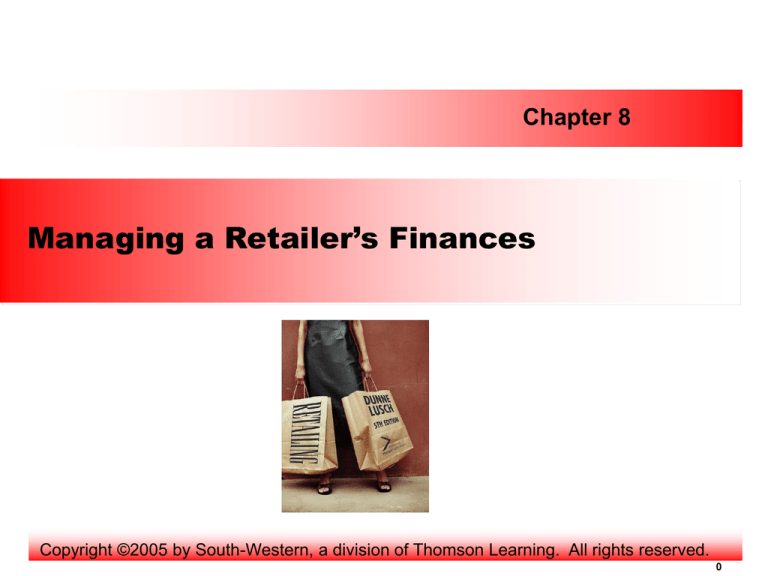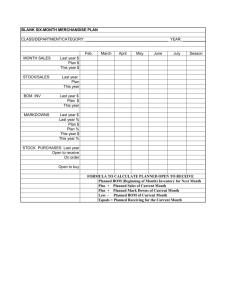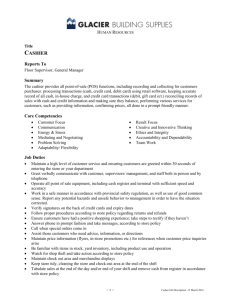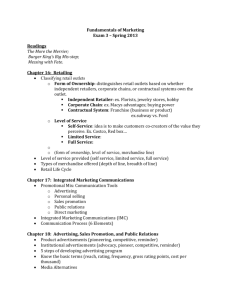
Chapter 8
Managing a Retailer’s Finances
Copyright ©2005 by South-Western, a division of Thomson Learning. All rights reserved.
0
Learning Objectives
• Describe the importance of a merchandise budget and
know how to prepare a six-month merchandise plan.
• Explain the differences among and the uses of these
three accounting statements: income statement,
balance sheet, and statement of cash flow.
• Explain how the retailer is able to value inventory.
1
The Merchandise Budget
LO 1
• Merchandising is the planning and control of the
buying and selling of gods and services to help the
retailer realize its objectives.
• Merchandise budget is a plan of projected sales for an
upcoming season, when and how much merchandise
is to be purchased, and what markups and reductions
will likely occur.
• Gross margin is the difference between net sales and
cost of goods sold.
2
Five Major Merchandising Decisions
LO 1
• What will be the anticipated sales for the department, division, or
store?
• How much stock on hand will be needed to achieve this sales
plan, given the level of inventory turnover expected?
• What reductions, if any, from the original retail price must be
made in order to dispose of all the merchandise brought into the
store?
• What additional purchases must be made during the season?
• What gross margin ( the difference between sales and cost of
goods sold) should the department, division, or store contribute
to the overall profitability of the company?
3
Four Rules in Preparing the Merchandise Budget
LO 1
• Always be prepared in advance of the selling season.
• The language of the budget must be east to
understand.
• Must be planned of a relatively short period of time (six
months is the norm used by most retailers).
• Flexible enough to permit changes.
4
Determining the Merchandise Budget
LO 1
• Determining Planned Sales
• Determining Planned BOM and EOM Inventories
• Determining Planned Retail Reductions
• Determining Planned Purchases at Retail and Cost
• Determining the Buyer’s Planned Gross Margin
5
Sample Six-Month Merchandise Budget
LO 1 Exhibit 8.1
6
Sample Six-Month Merchandise Budget
LO 1 Exhibit 8.1
7
Sample Six-Month Merchandise Budget
LO 1 Exhibit 8.1
8
Sample Six-Month Merchandise Budget
LO 1 Exhibit 8.1
9
Two-Seasons Department Store, Dept.353, SixMonth Merchandise Budget
LO 1 Exhibit 8.2
10
Determining Planned Sales: Formulas for the SixMonth Budget
LO 1: Exhibit 8.3
Determining Planned Sales for the Month
(Planned Sales Percentage for the Month )
X (Planned Total Sales)
= (Planned Sales for the Month)
11
Determining Planned Sales: Formulas for the SixMonth Budget
LO 1: Exhibit 8.3
Determining Planned BOM Stock for the Month
(Planned Sales for the Month ) X
(Planned BOM Stock-to-Sales Ratio for the Month)
= (Planned BOM Stock for the Month)
12
Determining Planned Sales: Formulas for the SixMonth Budget
LO 1: Exhibit 8.3
Determining Planned Retail Reductions
for the Month
(Planned Sales for the Month ) X
(Planned Retail Reduction Percentage for the Month)
= (Planned Retail Reduction for the Month)
13
Determining Planned Sales: Formulas for the SixMonth Budget
LO 1: Exhibit 8.3
Determining Planned EOM Stock for the Month
(Planned BOM Stock for the Following Month )
= (Planned EOM Stock for The Current Month)
14
Determining Planned Sales: Formulas for the SixMonth Budget
LO 1: Exhibit 8.3
Determining Planned Purchases at Retail
for the Month
(Planned Sales for the Month ) + (Planned Retail
Reductions for the Month) + (Planned EOM Stock for
the Month) - (Planned BOM Stock for the Month) =
(Planned Purchases at Retail for the Month)
15
Determining Planned Sales: Formulas for the SixMonth Budget
LO 1: Exhibit 8.3
Determining Planned Purchases at Cost
for the Month
(Planned Purchases at Retail for the Month )
X (100% Planned Initial Markup Percentage)
= (Planned Purchases at Cost for the Month)
16
Determining Planned Sales: Formulas for the SixMonth Budget
LO 1: Exhibit 8.3
Determining Planned Initial Markup
for the Month
(Planned Purchases at Retail for the Month ) X
(Planned Initial Markup Percentage) =
(Planned Initial Markup for the Month)
OR
(Planned Purchases at Retail for the Month) (Planned Purchases at Cost for the Month) =
(Planned Initial Markup for the Month)
17
Determining Planned Sales: Formulas for the SixMonth Budget
LO 1: Exhibit 8.3
Determining Planned Gross Margin
for the Month
(Planned Initial Markup for the Month) - (Planned
retail Reductions for the Month) = (Planned Gross
Margin for the Month)
18
How to Figure: Planned Sales for the Month
LO 1
Figures to calculate this formula are taken from Exhibit
8.2, Two-Seasons Department Store, Dept. 353, SixMonth Merchandise Budget.
10. Planned Sales Percentage for February 15%
Planned Sales for the period $500,000
2. Planned Sales for the month of February $75,000
19
How to Figure: Planned Sales for the Month
LO 1
(Planned Sales Percentage for the Month )
X (Planned Total Sales)
= (Planned Sales for the Month)
15%
=
X
500,000
75,000
20
How to Figure: Planned BOM Stock for the Month
LO 1
Figures to calculate this formula are taken from Exhibit
8.2, Two-Seasons Department Store, Dept. 353, SixMonth Merchandise Budget.
2. Planned Sales for February $75,000
9. Planned BOM Stock-to-Sales Ratio for February 3
1. Planned BOM Stock for the Month of February
$225,000
21
How to Figure: Planned BOM Stock for the Month
LO 1
(Planned Sales for the Month )
X (Planned BOM Stock-to-Sales Ratio for the Month)
= (Planned BOM Stock for the Month)
75,000
=
X
3
225,000
22
How to Figure: Planned Retail Deduction for the
Month
LO 1
Figures to calculate this formula are taken from Exhibit
8.2, Two-Seasons Department Store, Dept. 353, SixMonth Merchandise Budget.
2. Planned Sales for February $75,000
11. Planned Retail Deduction Percentage for February
10%
23
How to Figure: Planned Retail Deduction for the
Month
LO 1
(Planned Sales for the Month )
X (Planned Retail Reduction Percentage for the
Month)
= (Planned Retail Reduction for the Month)
75,000
=
X
10%
7,500
24
EOM Stock…BOM Stock
LO 1
Stock-to-Sales Ratio depicts the amount of stock to
have at the beginning of each month to support the
forecasted sales for that month.
25
EOM Stock…BOM Stock
LO 1
Figures to calculate this formula are taken from Exhibit
8.2, Two-Seasons Department Store, Dept. 353, SixMonth Merchandise Budget.
4. Planned EOM Stock for February $300,000
1. Planned BOM Stock for March $300,000
26
EOM Stock…BOM Stock
LO 1
(Planned BOM Stock for the Following Month )
= (Planned EOM Stock for The Current Month)
300,000
=
300,000
27
How to Figure: Planned Purchases at Retail for
the Month
LO 1
Figures to calculate this formula are taken from Exhibit
8.2, Two-Seasons Department Store, Dept. 353, SixMonth Merchandise Budget.
2. Planned Sales for February $75,000
3. Planned Retail Deduction for February $7,500
4. Planned EOM Stock for February $300,000
1. Planned BOM Stock for February $225,000
5. Planned Purchases at Retail for February $157,500
28
How to Figure: Planned Purchases at Retail for
the Month
LO 1
(Planned Sales for the Month )
+ (Planned Retail Reductions for the Month)
+ (Planned EOM Stock for the Month)
- (Planned BOM Stock for the Month)
= (Planned Purchases at Retail for the Month)
75,000
+
+
300,000
=
7,500
-
225,000
157,500
29
How to Figure: Planned Purchases at Cost for the
Month
LO 1
Figures to calculate this formula are taken from Exhibit
8.2, Two-Seasons Department Store, Dept. 353, SixMonth Merchandise Budget.
5. Planned Purchases at Retail for Month of February
$157,500
Planned Initial Markup Percentage 45%
30
How to Figure: Planned Purchases at Cost for the
Month
LO 1
(Planned Purchases at Retail for the Month )
X (100% - Planned Initial Markup Percentage)
= (Planned Purchases at Cost for the Month)
157,500
X
=
(100 - 45%)
86,625
31
How to Figure: Planned Initial Markup for the
Month, First Formula
LO 1
Figures to calculate this formula are taken from Exhibit
8.2, Two-Seasons Department Store, Dept. 353, SixMonth Merchandise Budget.
5. Planned Purchases at Retail for February $157,500
Planned Initial Markup Percentage 45%
7. Planned Initial Markup for February $70,875
32
How to Figure: Planned Initial Markup for the
Month, First Formula
LO 1
(Planned Purchases at Retail for the Month )
X (Planned Initial Markup Percentage)
= (Planned Initial Markup for the Month)
157,500
X
=
45%
70,875
33
How to Figure: Planned Initial Markup for the
Month, Second Formula
LO 1
Figures to calculate this formula are taken from Exhibit
8.2, Two-Seasons Department Store, Dept. 353, SixMonth Merchandise Budget.
5. Planned Purchases at Retail for February $157,500
6. Planned Purchases at Cost for February $86,625
7. Planned initial Markup for February $70,875
34
How to Figure: Planned Initial Markup for the
Month, Second Formula
LO 1
(Planned Purchases at Retail for the Month)
- (Planned Purchases at Cost for the Month)
= (Planned Initial Markup for the Month)
157,500
-
=
86,625
70,875
35
How to Figure: Planned Gross Margin for the
Month
LO 1
Figures to calculate this formula are taken from Exhibit
8.2, Two-Seasons Department Store, Dept. 353, SixMonth Merchandise Budget.
3. Planned Retail Reduction for February $7,500
7. Planned Initial Markup for February $70,875
8. Planned Gross Margin for February $63,375
36
How to Figure: Planned Gross Margin for the
Month
LO 1
(Planned Initial Markup for the Month )
- (Planned Retail Reductions for the Month)
= (Planned Gross Margin for the Month)
-
70,875
=
7,500
63,375
37
Blank Six-Month Merchandise Budget
LO 1
Six-Month
Merchandise
Budget
Date_____________________
Season____________________
Spring/Summer
Feb
Mar
Apr
May
Jun
Jul
Seasonal
Fall/ Winter
Aug
Sep
Oct
Nov
Dec
Jan
Total
1. Planned BOM Stock
2. Planned Sales
3. Planned Retail Reductions
4. Planned EOM Stock
38
Blank Six-Month Merchandise Budget
LO 1
Six-Month
Merchandise
Budget
Date_____________________
Season____________________
Spring/Summer
Feb
Mar
Apr
May
Jun
Jul
Seasonal
Fall/ Winter
Aug
Sep
Oct
Nov
Dec
Jan
Total
5. Planned Purchases @ Retail
6. Planned Purchases @ Cost
7. Planned Initial Markup
8. Planned Gross Margin
39
Blank Six-Month Merchandise Budget
Six-Month
Merchandise
Budget
LO 1
Date_____________________
Season____________________
Spring/Summer
Feb
Mar
Apr
May
Jun
Jul
Seasonal
Fall/ Winter
Aug
Sep
Oct
Nov
Dec
Jan
Total
9. Planned BOM
Stock/Sales Ratio
10. Planned Sales Percentage
11. Planned Retail Reduction
Planned Total Sales for the Period
____________________
Planned Total Retail Reduction Percentage for the Period ____________________
Planned Initial Markup Percentage for the Period
____________________
Planned BOM Stock for ________________
____________________
40
Blank Three-Month Merchandise Budget
LO 1
Three-Month
Merchandise
Budget
Date_____________________
Season____________________
Spring/Summer
February
Fall/ Winter
August
March
September
April
October
Seasonal
Total
1. Planned BOM Stock
2. Planned Sales
3. Planned Retail Reduction
4. Planned EOM Stock
41
Blank Three-Month Merchandise Budget
LO 1
Three-Month
Merchandise
Budget
Date_____________________
Season____________________
Spring/Summer
February
Fall/ Winter
August
March
September
April
October
Seasonal
Total
5. Planned Purchases @Retail
6. Planned Purchases @ Cost
7. Planned Initial Markup
8. Planned Gross Margin
42
Blank Three-Month Merchandise Budget
Three-Month
Merchandise
Budget
LO 1
Date_____________________
Season____________________
Spring/Summer
February
Fall/ Winter
August
March
September
April
Seasonal
October
Total
9. Planned BOM
Stock/Sales Ratio
10. Planned Sales Percentage
11. Planned Retail Reduction
Planned Total Sales for the Period
____________________
Planned Total Retail Reduction Percentage for the Period ____________________
Planned Initial Markup Percentage for the Period
____________________
Planned BOM Stock for ________________
____________________
43
Retail Accounting Statements
LO 2
• Income Statement
• Balance Sheet
• Statement of Cash Flow
44
Income Statement
LO 2
• Income Statement is a financial statement that provides a
summary of the sales expenses for a given time period, usually a
month, quarter, season, or year.
• Gross Sales are the retailer’s total sales including sales for cash
or credit.
• Returns and Allowances are the refunds of the purchase price or
downward adjustments in selling prices due to customers
returning purchases, or adjustments made in the selling price due
to customer dissatisfaction with the product or service
performance.
45
Income Statement
LO 2
• Net Sales is the gross sales less returns and
allowances.
• Cost of Goods Sold is the cost of merchandise that
has been sold during the period.
• Operating Expenses are those expenses that a retailer
incurs in running the business other than the cost of
the merchandise.
46
Income Statement
LO 2
• Operating Profit is gross margin less operating
expenses.
• Other Income or Expenses includes income or
expense items that the firm incurs which are not in the
course of its normal retail operation.
• Net Profit is operating profit plus or minus other
income or expenses.
47
Graphic Presentation of the Income Statement
LO 2
Gross
Sales
Returns &
Allowances
Net
Sales
Cost of
Goods
Sold
Gross
Margin
Operating
Expenses
Operating
Profit
48
Retailers’ Basic Income Statement Format
LO 2: Exhibit 8.5a
Gross Sales
- Returns and Allowances
Net Sales
- Cost of Goods Sold
Gross Margin
- Operating Expenses
Operating Profit
± Other Income or Expenses
Net Profit Before Taxes
$____________
$____________
$____________
$____________
$____________
$____________
$____________
$____________
$____________
49
Sample Income Statement
LO 2: Exhibit 8.5b
50
Sample Income Statement
LO 2: Exhibit 8.5b
51
Balance Sheet
LO 2
Balance Sheet identifies and quantifies all of the firm’s
assets and liabilities at a particular point in time.
Asset is anything of value that is owned by the retail
firm.
Current Assets are assets that can be easily converted
into cash within a relatively short period of time
(usually a year or less).
Accounts and/or Notes Receivable are amounts that
customers owe the retailer for goods and services.
52
Balance Sheet
LO 2
Prepaid Expenses are those items for which the
retailer has already paid, but the service has not been
completed.
Retail Inventories comprise merchandise that the
retailer has in the store or in storage and is available
for sale.
Noncurrent Assets are those that cannot be converted
to cash in a short period of time (usually 12 months) in
the normal course of business.
53
Balance Sheet
LO 2
Goodwill is an intangible asset, usually based on
customer loyalty, that a retailer pays for when buying
an existing business.
Total assets equal current assets plus noncurrent
assets plus goodwill.
Liability is any legitimate financial claim against the
retailer’s assets.
Current Liabilities are short-term debts that are
payable within a year.
54
Balance Sheet
LO 2
Accounts Payable are amounts owed vendors for
goods and services.
Long-Term Liabilities are debts that are due in a year
or longer.
Total Liabilities equal current liabilities plus long-term
liabilities.
Net Worth (owner’s equity) is total assets less total
liabilities.
55
Graphic Presentation of the Balance Sheet
LO 2
Current Assets
Current
Liabilities
Long Term
Liabilities
Fixed Assets
Net Worth
56
Retailers’ Basic Balance Sheet Format
LO 2: Exhibit 8.6a
Current Assets
Cash
Accounts Receivable
Inventory
Prepaid Expenses
Total Current Assets
Noncurrent Assets
Building (less depreciation)
Fixtures and Equipment
(less depreciation)
Total Noncurrent Assets
Goodwill
Total Assets
$____________
$____________
$____________
$____________
$____________
$____________
$____________
$____________
$____________
$____________
57
Retailers’ Basic Balance Sheet Format
LO 2: Exhibit 8.6a
Current Liabilities
Accounts Payable
Payroll Payable
Current Notes Payable
Taxes Payable
Total Current Liabilities
Long-term Liabilities
Long-term Notes Payable
Mortgage Payable
Total Long-term Liabilities
Net Worth
Capital Surplus
Retained Earnings
Total Net Worth
Total Liabilities and
Net Worth
$____________
$____________
$____________
$____________
$____________
$____________
$____________
$____________
$____________
$____________
$____________
$____________
58
Retailers’ Basic Balance Sheet Format
LO 2: Exhibit 8.6b
59
Statement of Cash Flow
LO 3
• Statement of cash flow
lists in detail the sources and type of all revenue (cash
inflows) and the use and type of all expenditures (cash
outflows) for a given time period.
60
Retailing Truism
Cash “in” must always exceed cash “out” (if you want
to stay in business).
61
Sample Cash Flow Statement
LO 2: Exhibit 8.7a
62
Typical Cash Inflow and Outflow Categories
LO 2: Exhibit 8.7b
Cash Inflow
Cash sales
Collecting accounts receivable
Collecting notes receivable
Collecting other debts
Sales of fixed assets
Sale of stock
Cash Outflows
Paying for merchandise
Rent expenses
Utilities expenses
Wages and Salary expenses
Advertising expense
Insurance premiums
Taxes
Interest expenses
Supplies and other expenses
Purchase of other assets
Paying off accounts payable
Paying off notes payable
Buying back company stocks
Paying dividends
63
Inventory Valuation
LO 3
• Accounting Inventory System
• Inventory Pricing Systems
64
Accounting Inventory System
LO 3
• Cost Method is an inventory valuation technique that
provides a book valuation of inventory based solely on
the retailer’s cost of merchandise including freight.
• Retail Method is an inventory valuation technique that
values merchandise at current retail prices, which is
then converted to cost based on a formula.
65
Steps for Using the Retail Method of Inventory
Valuation
LO 3
• Calculation of the cost complement.
• Calculation of reductions from retail value.
• Conversion of the adjusted retail book inventory to
cost.
66
Retail Method of Inventory Valuation Example
LO 3
Cost
Retail
$25,000
45,000
Inventory at Beginning of Period
$14,000
Purchases During the Period
30,000
Transportation Costs
1,000
Additional Markups
5,000
Merchandise Available for Sale
45,000
75,000
Cost to Retail Ratio and Percentage 45,000 / 75,000 = 60%
Net Sales
45,000
Markdowns
5,000
Total Reductions
50,000
Ending Inventory at Retail
$25,000
Ending Inventory at Cost ($25,000 X .60) $15,000
67
Advantages of the
Cost Method of Inventory Valuation
LO 3
• Accounting statements can be drawn up at any time.
Inventories need not be take for preparation of these
statements.
• Physical inventories using retail prices are less
subject to error and can be completed in a shorter
amount of time.
• The retail method provides an automatic, conservative
valuation ending inventory as well as inventory levels
throughout the season.
68
Inventory Available for Whitener’s
Sporting Goods Sale, Fall Season
LO 3: Exhibit 8.8
Cost
Beginning Inventory
Net Purchases
Additional Markups
Freight-in
Total Inventory Available
for Sale
$199,000
70,000
1,000
$270,000
Retail
$401,000
154,000
5,000
$560,000
69
Whitener’s Sporting Goods Sale, Ending Book
Value at Retail, Fall Season
LO 3: Exhibit 8.9
Cost
Inventory Available for Sale at Retail
Less Reductions:
Sales
$145,000
Markdowns
12,000
Discounts
$ 2,000
Total Reductions
Ending Book Value of Inventory
at Retail
Retail
$560,000
159,000
$401,000
70
Whitener’s Sporting Goods, Stock Shortage (overage)
Adjustment Entry, Fall Season
LO 3: Exhibit 8.10
Cost
Ending Book Value of Inventory at Retail
Physical Inventory (at retail)
Stock Shortages
Adjusting Ending Book Value of Inventory at Retail
Retail
$401,000
398,000
3,000
$398,000
71
Whitener’s Sporting Goods
Income Statements August 1-January 31
LO 3: Exhibit 8.11
Cost
Sales
Less Cost of Goods Sold:
Beginning Inventory (at Cost)
$200,000
Purchases (at Cost)
70,000
Goods Available for Sale
$270,000
Ending Inventory (at Cost)
191,836
Cost of Goods Sold
Gross Margin
Less: Operating Expenses
Salaries
$ 30,000
Utilities
1,000
Rent
19,000
Depreciation (Fixtures + Equipment)
2,200
Total Operating Expenses
Net Profit Before Taxes
Retail
$145,000
78,164
$66,836
52,200
$14,636
72
Inventory Pricing Systems
LO 3
• FIFO stands for first in, first out and values inventory
based on the assumption that the oldest merchandise
is sold before the more recently purchased
merchandise.
• LIFO stands for last in, first out and values inventory
based on the assumption that the most recently
purchased merchandise is sold first and the oldest
merchandise is sold last.
73
Effect of Inventory Pricing System on Gross
Margin
LO 3
LIFO
FIFO
Net sales
$8,400
$8,400
Less: Cost of goods sold
$4,500
$4,500
4,000
4,000
Goods available
$8,500
$8,500
Ending inventory
4,500
4,900
Cost of goods sold
4,000
3,600
$4,400
$4,800
Beginning Inventory
Gross Margin
74
Question to Ponder
• Retailers are given a choice as to whether to use the
LIFO or FIFO method. Given such a choice, would it
make a difference in the selection of a method if the
retailer were privately owned versus being a publicly
traded company?
75
76







